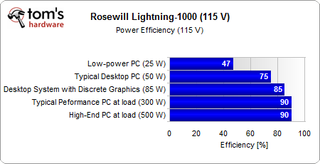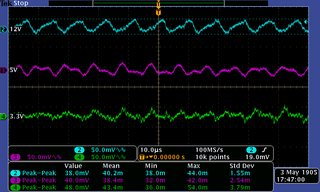Three 1000 W 80 PLUS Gold-Certified Power Supplies Tested
We received a trio of 1000 W power supplies priced between $200 and $300, so we ran them through our usual suite of tests to see if they really live up to their 80 PLUS Gold certifications. Surprisingly, all three hiccuped during efficiency testing.
Rosewill Lightning-1000: Measurements
Efficiency in accordance with the 80 PLUS specification


Efficiency, based on performance profiles


The Rosewill Lightning-1000 leaves a mixed impression in our test lab. It misses the 80 PLUS Gold certification threshold by nearly two percentage points under full load, even if it hits the target at 50% and 20% load. The sharp fall of energy efficiency at low loads is striking, as the device achieves just 47% efficiency at a 25 W load. In other words, more than half of the power is wasted as heat, making the 80 PLUS Gold logo look quite out of place. However, in the defense of the PSU it should be mentioned that a 1000 W PSU is not intended for such low loads, and the efficiency is fine at 50 W and up.
The ripple/noise measurements are good, and the same goes for the other tests. The EuP standby power limit is not a problem, nor is the noise level.

The Rosewill Lightning-1000 deserves some criticism. It has some smart details and stands out from the crowd visually. But the missed 80 PLUS Gold threshold and the very sharp fall in efficiency at low loads dim the overall impression.
Stay on the Cutting Edge
Join the experts who read Tom's Hardware for the inside track on enthusiast PC tech news — and have for over 25 years. We'll send breaking news and in-depth reviews of CPUs, GPUs, AI, maker hardware and more straight to your inbox.
Current page: Rosewill Lightning-1000: Measurements
Prev Page Rosewill Lightning-1000 Next Page Sparkle GW-EPS1250DA-
killbits hmm, maybe next time include a super-high-end psu that doesn't suck.Reply
http://www.newegg.com/Product/Product.aspx?Item=N82E16817139014
takes any of the psu's in this review to school. -
mr_cb7 Replyhmm, maybe next time include a super-high-end psu that doesn't suck.
Seriously where is PC Power & Cooling,Corsair, or Antec!
OCZ and Rosewill thats it? OCZ is alright, but Rosewill is crap.
try theses next time:
http://www.pcpower.com/power-supply/turbo-cool-1200.html (not GOLD I know but still)
http://www.newegg.ca/Product/Product.aspx?Item=N82E16817139014
http://www.ncix.com/products/?sku=56794&vpn=HCP-1200&manufacture=Antec -
one-shot I have a 750W Corsair PSU. When gaming with my i7 920 @ stock and SLI GTX 260s, I haven't come close to 400watts, according to my UPS. If you take the number the UPS gives and factor in the efficiency of the PSU, the power draw is much less. I've seen up to 360 watts with TF2 and Test Drive Unlimited 2 so far. Although running burn tests on GPUs and CPU will draw much more.Reply
Running Bionc on CPU and F@H on both GPUs, I draw 441 watts with ALL components under HEAVY load. That's 100% on all CPU threads and GPUs. 1000W is enough for a lot of components.
I also idle at 189 Watts with SLI enabled. -
Chewie Call me a noob if you like, but I didn't realise using 230V was more efficient 115V. I guess that's a bonus for those of us down under.Reply
I just wish I could afford the kind of components that would require this kind of PSU. -
alidan ChewieCall me a noob if you like, but I didn't realise using 230V was more efficient 115V. I guess that's a bonus for those of us down under.I just wish I could afford the kind of components that would require this kind of PSU.Reply
can someone explain this to me, because i dont get it. -
tuhinz Reply9509055 said:can someone explain this to me, because i dont get it.
Its got to do with varying efficiency at different voltage levels.
Consider the following:
Power(P) = Voltage(V) X Current (I) X Power factor (Cos phi)
Now for the same amount of power transfer, at lower voltages, the current required is more (See the equation below):
P = V1 X I1 X Cos phi1 = V2 X I2 X Cos phi2
(Substitute for V1 = 230, V2 = 115, neglect the slight difference in Cos phi1 & Cos phi2)
The losses are given by :
H =I^2 X R X t (where R is the resistance of the current carrying conductor, t is time)
Thus losses increase in proportion to the current squared.
So you have higher losses (hence lower efficiency) at lower voltages. -
jimishtar "Max. temperature difference air intake to outlet - less is better "Reply
where's the logic in this?
bigger temp difference means the cooling system is more efficient and it takes the heat away from the components. why is air temp so important to you? If you cannot measure temp from inside the psu case (the components) why bother with air temp? -
tuhinz Reply9509057 said:than why can you switch between? thats what im not understanding.
You can't switch between the two. US & Japan & some S. American countries (IIRC) use 115V while the rest of the world uses 230V. PSUs meant for both markets often have a switch and you need to set it to the correct voltage for your country and plug it in. Many modern PSUs will often have a large input voltage range spanning both the voltage levels so you won't find the switch in them (My Corsair TX650 for instance).
Most Popular

